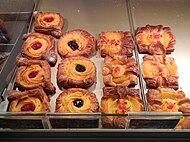Yonderian pastry

Pastries, known in Burgoignesc as Rouléeserie (Rolled thing), are baked goods made from a yeast-leavened dough in a manner similar to bread with added ingredients (particularly eggs, butter, milk, cream and sugar) giving them a richer, sweeter character. The dough is often laminated, being formed of many thin layers atop one another. Pastries are an important aspect of Yonderian cuisine, being one of the cornerstones of the full Yonderian breakfast. Pastries are also consumed as snacks, particularly with afternoon coffee.
The modern style of Yonderian pastries originated in Collinebourg, Yonderre in the early 19th century out of previous simpler pastries like sweet rolls and confectionery. They were initially viewed as a delicacy for the upper class due to the price of expensive spices like cinnamon and cardamom often used, but soon earned their place as a common breakfast item for the ordinary folk. Yonderian pastries come in many variants, sizes and shapes. They are generally named after the town or region they originated in, although some take their names from historical events or characters.
Variations
Collinebourger
The original style of Yonderian pastry, a Collinebourger is an airy, laminated pastry with a filling of remonce, a filling made from gently mixed creamed butter and sugar with vanilla and chopped almonds. Collinebourg-style pastries are often decorated with blue poppy seeds. The Collinebourger is often split on the middle horizontally so that a layer of butter may be added to the remonce, adding to the flavour. In Collinebourg this pastry is often simply referred to as a rouleau, a "roll".
Dansberger
The Dansberg-style pastry is made from laminated dough interleaved with copious amounts of pecan nuts, cardemom and syrup to create a round and sweet flavour with a touch of spice. Often decorated with chopped pecan nuts on top.
Donnebourger
The Donnebourg-style pastry is a circular pastry directly descended from the sweet rolls that preceded modern Yonderian pastries. It consists of a rolled sheet of yeast-leavened dough onto which a cinnamom and sugar mixture is sprinkled over a thin coat of butter. The dough is the nrolled, cut into individual portions and baked or deep fried. Its main ingredients are flour, cinnamon, sugar and butter, which provide a robust and sweet flavour. Donnebourgers come in various sizes ranging from five centimeters across to upwards of twenty centimeters. Also sometimes referred to as escargots, "snails".
Gabionesc
The Gabionesc-style pastry is an airy, laminated pastry with a filling known as Baron-filling, a mixture of marzipan, margarine and sugar in a 1:1:1 mix in a bowl-shape. In the center of the bowl is a filling of typically either creme custard or raspberry jam. The Gabionesc is typically decorated with frosting and chopped hazelnuts.
Vallonbourger
The Vallonbourg-style pastry is made from a typically airy, laminated dough which is shaped to resemble two crossed arms. Vallonbourgers are often glazed with fine white frosting and various chopped nuts like hazel or almonds.
Willinger
Also sometimes referred to as a long Collinebourger, the Willinger is made from the same dough as a Collinebourger but stretched and interleaved to a different, oblong shape.
- Yonderian pastries
-
Several types of Yonderian pastry in a bakery in Collinebourg
-
Dansberger
-
Donnebourger
-
Gabionesc



